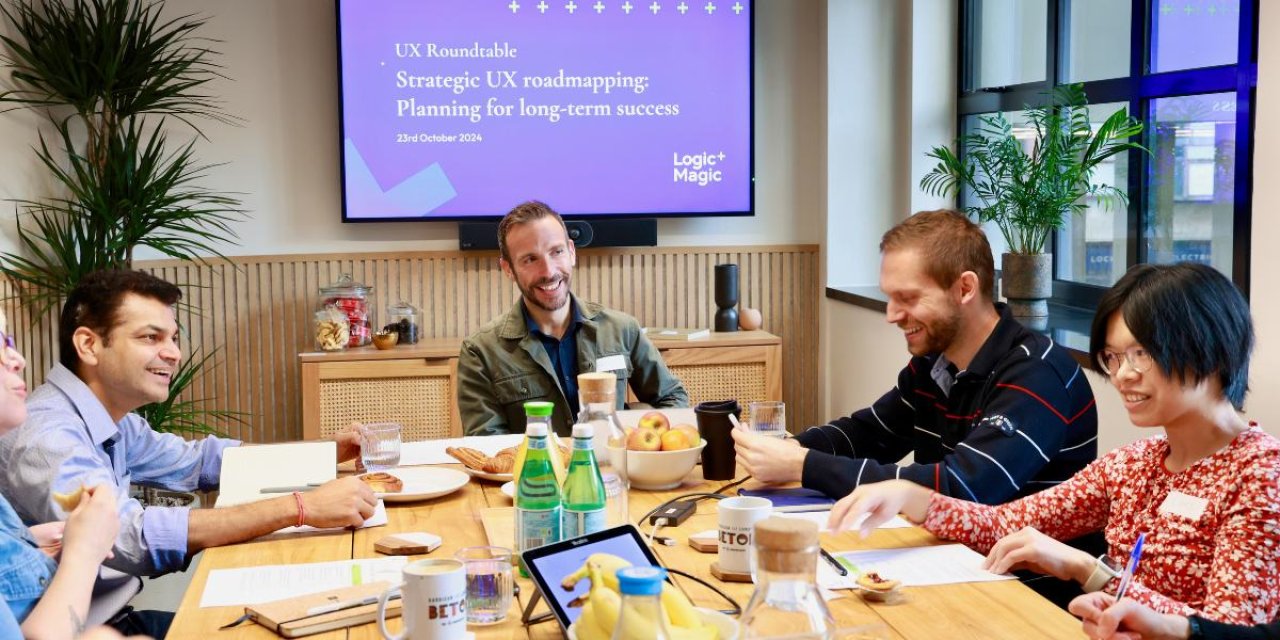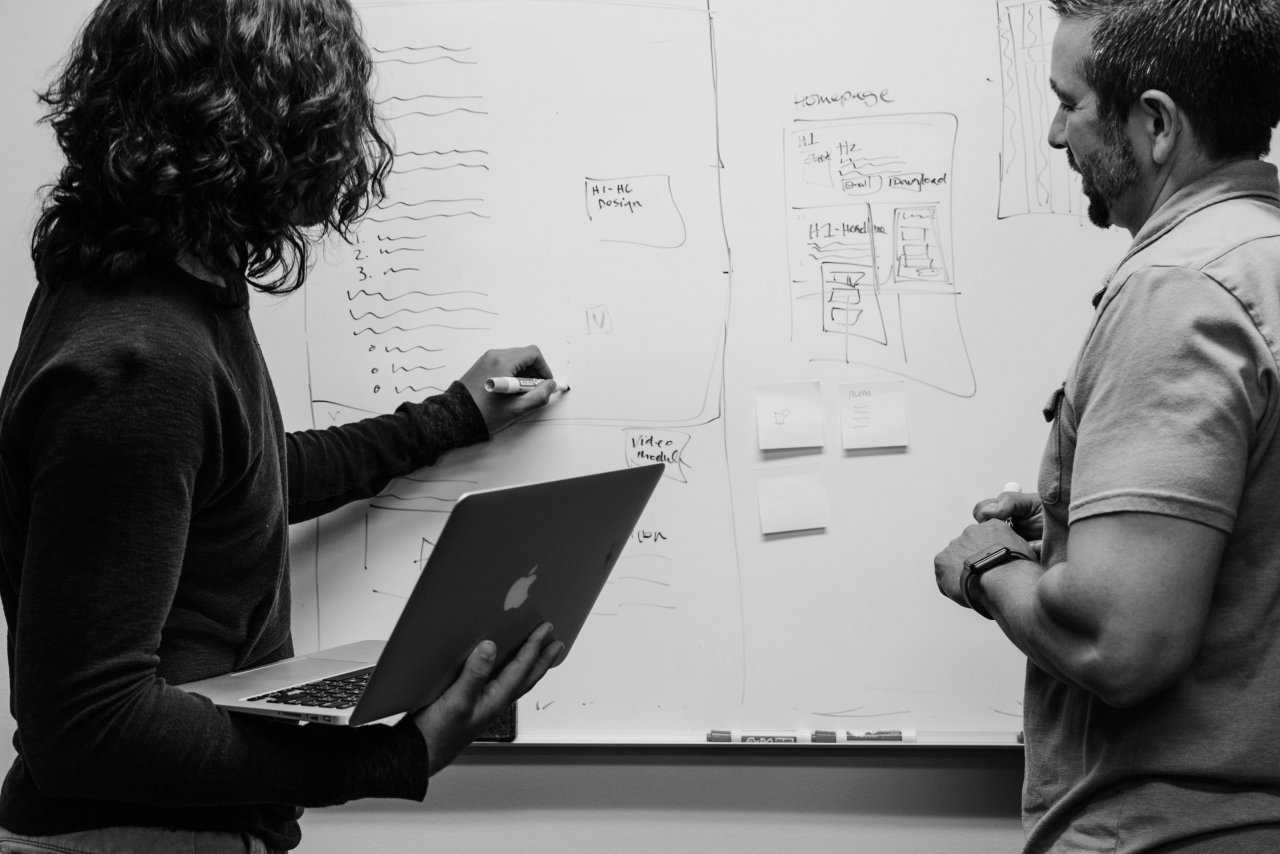Logic+Magic has been hosting a series of UX round tables with senior UX leaders to understand what’s keeping them up at night, explore solutions, share findings with other clients, and keep our own practices sharp and relevant. In late summer 2023, we spent 90 minutes in conversation with Venessa Bennett, David Fagg, Christian Fradet, Lori Ho, Parklins Ifeanyichukwu, and Adam de Linde to investigate how UX teams can help their colleagues embrace the value of the discipline in order to maximise the impact they make to the design and development process.
This blog summarises the seven key learnings from that conversation.
Culture and process
“Can I have the wireframes by Friday?”
UX professionals get asked for artefacts all the time. And so they should. Colleagues need to get stuff done and are generally seeking to bring together lots of moving parts into one coherent plan.
So how should UX professionals respond if the answer should be no, or a different output would make a more valuable contribution?
Sometimes that function shouldn’t be added to that product
Sometimes a sketch (taking 30 minutes) is a more efficient output than a wireframe (taking half a day)
Sometimes a conversation will gain a better outcome than an artefact
Sometimes a compromise needs to be reached between effort and impact
How do we hold on to our professional integrity without sounding like a bunch of prima donnas? There is no right or easy answer, but our delegates suggested some helpful approaches that they previously found useful.
Get involved in the conversation before it reaches you – rather than being at the end of a brief, be part of the discussions that led up to the brief, so you can influence what is delivered
Work in cross-disciplinary teams – the team of three comprising a product owner, developer and UXer can be an effective unit, driving overall product vision while embracing the necessary trade-offs in design and development
Explore why a colleague has asked you for the output – to gain a better understanding of what they need the output to deliver; this can open the door to discovering an alternative, potentially superior approach
Product-led companies
“I find that it’s often about adapting technology for humans.”
There is no denying that the world’s most profitable digital and tech companies have product-first and design-led leaders. Jobs at Apple, Bezos at Amazon, Page, and Brin at Google all had very clear visions for the products under their care. Those businesses outperformed many of their rivals in incredibly competitive markets. Apple didn’t invent the tablet, the smartphone, or the MP3 player yet they innovated them towards market dominance. Amazon was part of the explosion of e-commerce start-ups in the mid-1990s yet prevailed to become the most valuable e-commerce platform on the planet. Google have diversified with such success that it almost goes unchallenged nowadays that a search engine company should launch an office suite of products, a browser, and a range of other software.
One contributor observed how Jony Ive was the yin to Steve Job’s yang, and how product and design worked in wonderful harmony.
The challenge lies at the boardroom table. Savvy chairs and CEOs must ensure that if they aren’t product-led themselves that the product function is represented at the board and C-suite level. A director wouldn’t dream of attending a board meeting and ignoring the P&L because “finance isn’t my specialism”, and so in today’s world, the board needs a high degree of product and design literacy, supported by board-level product specialism.

The business case
“If you don’t test a product, you will almost definitely lose customers.”
In many cases, non-designers don’t appreciate the importance of user validation, particularly when it’s early in the design process. Early user validation is to product what early revenue is to investment – it reinforces (or contradicts depending on outcome) that an idea is a good one, that it is workable, and that real humans in the real world attribute value to it. A business with early revenue is of more value than an identical business with no revenue, so too a product with early user engagement and direction is of more value than an identical product with no user input.
User input trumps interface prettiness every time.
Non-UX colleagues probably don’t know this and nor should they have to. It’s the role of designers to work hard to reframe their work, where appropriate, in a commercial context. UX strategy focuses on connecting user satisfaction with business success, there is rarely a contradiction between serving the user and meeting commercial targets.
UX professionals need to become experts at helping colleagues connect those dots.
Knowledge sharing
“Slow down and fix the problem faster.”
All of us as professionals learn an enormous amount by observing colleagues and mimicking our leaders. Often it is only in hindsight that we can recognise the enormous amount we learned from former bosses and peers. Learning that way is highly effective because everyone is pursuing the same aim (getting stuff done) and the learning is typically observation-led, task-focused, and non-preachy.
One of our attendees summarised it perfectly, “It’s the profile and communication of UX and design to colleagues. It’s not about assigning a designer. When launching a new product, for instance, it’s important to slow down, understand the problem, run workshops and you get to fix the problem faster. Bring everyone along on the journey.”
Language
“Colleagues are separated by a common language.”
We acknowledge we stole the quote from one of George Bernard Shaw, Mallory Browne, Raymond Gram Swing, or Oscar Wilde, but hopefully, the point still stands!
Many terms which are familiar to UX professionals carry baggage. Even the term UX means different things to different people. UX and UI are often intertwined, much to the chagrin of those working in the sector. Even the word design, to some people, means decoration or prettiness.
Designers are hard-wired to be empathetic to the end users for whom they are designing. Holistic UX encourages all of us to be considerate to all stakeholders, including our colleagues in other disciplines. Just because designers have been clawing for what seems like forever to get respect within organisations, it doesn’t mean that we are the centre of their universe, nor should we be.
We need to understand our colleagues, empathise with them, understand them from a position of humility, and engage with them using an unambiguous language which they understand.
Systems thinking
“Two days of understanding what’s needed means just one hour of design.”
The pursuit of context has always been a valuable weapon in the designer’s arsenal. Architects are interested in a building’s relationship with light, with the people who use it, and with surrounding buildings. Fashion designers spend time thinking about the seasons a garment will be worn in and the social environments within which it needs to make a statement. UX designers consider user goals, behaviour, and context when seeking to contribute empathy and anticipation to the interfaces and flow they design.
This same pursuit of context is helpful in exploring why someone has been given a particular brief. Getting beyond the brief to the problem behind the brief, or the need which is seeking to be addressed can be a valuable way to gain internal credibility and shorten lead time for work.
Want to make sure you always produce the most suitable output? Invest time in understanding the desired outcome.
Awareness and deliberate action
The group concluded that while designers and researchers aren’t in full control of all the variables, we can be deliberate and empathetic in how we help our colleagues embrace UX as part of the design and development process. There are no easy answers, and soft skills are as important as hard skills, but user experience and design thinking provide us with some valuable models by which we can frame our contribution and show the same care and attention to colleagues as we do to our users.





.png)

